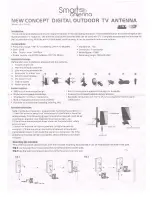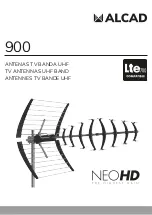
•
Wideband – suitable for all UK TV reception areas,
covering UHF channels 21 to 68
•
Receives both digital and analogue TV signals
•
Suited for
strong
signal strength areas only
The aerial requires a minimal amount of assembly (attaching
the reflectors) - please read these instructions carefully before
starting assembly and installation.
Main Features
Congratulations on the purchase of your wideband aerial. The aerial is
designed to receive both analogue and digital terrestrial signals.
It has been manufactured to the standard required to get the best reception
of digital terrestrial TV services (Freeview™) in strong to medium strength
signal areas.
If the aerial is to be used for Freeview™ reception check before installation at
www.dtg.org.uk/industry/coverage.html
to confirm that your home
is in a coverage area and to find out where your local transmitter is.
For optimum results install the aerial using double screened digital
coax cable and screened coax outlets.
User GUide
Please Note: Coaxial cable, mountings and masts are not
supplied with this aerial. You will need to select these from the
range available according to the specific requirements of your
installation. The quality of the coaxial cable used is important
especially for long cable runs wherever possible use CAI approved
double screened satellite cable such as PF100.
10 Element Wideband Digital Aerial
1. Using the reflector clamps, screw and large wing nut, fix
the reflector assemblies to the main aerial boom as
shown in Fig. 1 & Fig.2.
2. Check that the reflector clamp tabs locate in the holes
of the reflector boom sections and that the wing nut
is tight as shown in Fig. 2.
3. Ensure that the reflector elements are facing towards the
front of the aerial (convex surface forward).
A. Fitting the reflectors
engage
tab
in hole
reflector
element
reflector boom
assembly
reflector
clamps
front of aerial
Fig. 1
Fig. 2
Safety Warnings
Before starting installation ensure that the structure to which you intend to
attach your aerial is sound and check for hidden electrical wiring or plumbing.
When working on an installation outside, beware of overhead power lines.
Observe safe working practices, tread carefully and ensure adequate lighting
is available in loft or roof space.
Before making any connections switch electricity off at the mains.
Always follow manufacturer’s operating and safety instructions before using
tools and/or equipment.
Ladder Safety-always read and follow the manufacturer’s instruction label
affixed to the ladder.
To avoid injury always route cables or wiring carefully.
If you experience difficulties installing your aerial consult a qualified installer.




















